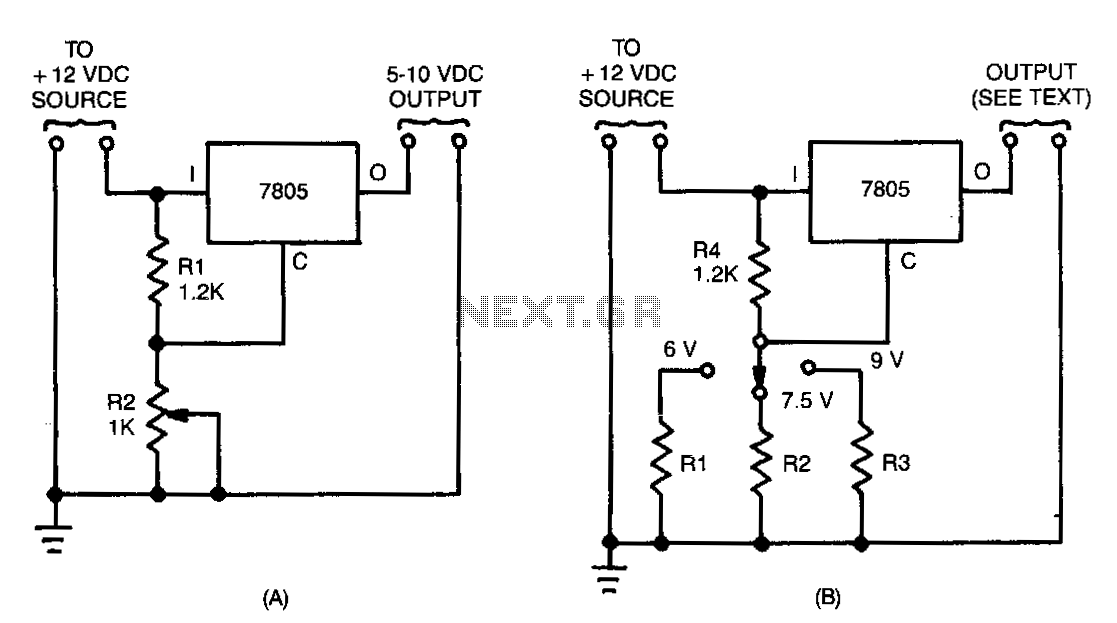
12-16V-converter

Many devices operate from a car's 12-V electrical system. Some require 12 V, while others need a lower voltage. An automobile battery's output can vary from 12 to 13.8 V under normal circumstances. The load requirements of the device may also change. This circuit maintains a constant voltage regardless of these factors. A simple circuit uses a 7805 voltage regulator. In addition to providing a constant output, this circuit includes overload and short-circuit protection. The 7805 unit is a 5-V, 1-A regulator, but when integrated into another circuit, it can deliver different voltages. By adjusting the arm of potentiometer R1 toward ground, the output can vary from 5 to approximately 10 V.
The described circuit employs the 7805 voltage regulator, a popular choice for providing a stable 5 V output from a variable input voltage, such as that found in automotive applications. The 7805 is designed to deliver a maximum current of 1 A, making it suitable for various electronic devices that require a consistent voltage supply.
To implement the circuit, the 7805 is connected to the car's 12-V electrical system, which serves as the input voltage. The output of the regulator is connected to the load, ensuring that it receives a stable 5 V, even as the input voltage fluctuates between 12 to 13.8 V due to changes in the battery state or other factors.
In addition to the voltage regulation capabilities, the circuit is equipped with overload and short-circuit protection features, which are crucial for safeguarding both the regulator and the connected devices. These protections help prevent damage in the event of excessive current draw or a fault condition.
The inclusion of potentiometer R1 allows for adjustable output voltage in a modified configuration of the circuit. By varying the position of the potentiometer's arm toward ground, the output voltage can be increased from the standard 5 V up to approximately 10 V. This adjustability makes the circuit versatile, accommodating various devices with different voltage requirements.
Overall, this voltage regulation circuit is an effective solution for powering devices from a car's electrical system, ensuring consistent performance while providing essential protection features.Many devices operate from a car"s 12-V electrical system. Some require 12 V; others require some lesser voltage. An automobile battery"s output can vary from 12 to 13.8 V under normal circumstances. The load requirements of the device might vary. This circuit maintains a constant voltage regardless of how those factors change. Simple circuit, A, uses a 7805 voltage regulator. In addition to a constant output, this JC provides overload and short-circuit protection. That unit is a 5-V, 1-A regulator, but when placed in circuit B, it can provide other voltages as well. When the arm of potentiometer R1 is moved toward ground, the output varies from 5 to about 10 V.
The described circuit employs the 7805 voltage regulator, a popular choice for providing a stable 5 V output from a variable input voltage, such as that found in automotive applications. The 7805 is designed to deliver a maximum current of 1 A, making it suitable for various electronic devices that require a consistent voltage supply.
To implement the circuit, the 7805 is connected to the car's 12-V electrical system, which serves as the input voltage. The output of the regulator is connected to the load, ensuring that it receives a stable 5 V, even as the input voltage fluctuates between 12 to 13.8 V due to changes in the battery state or other factors.
In addition to the voltage regulation capabilities, the circuit is equipped with overload and short-circuit protection features, which are crucial for safeguarding both the regulator and the connected devices. These protections help prevent damage in the event of excessive current draw or a fault condition.
The inclusion of potentiometer R1 allows for adjustable output voltage in a modified configuration of the circuit. By varying the position of the potentiometer's arm toward ground, the output voltage can be increased from the standard 5 V up to approximately 10 V. This adjustability makes the circuit versatile, accommodating various devices with different voltage requirements.
Overall, this voltage regulation circuit is an effective solution for powering devices from a car's electrical system, ensuring consistent performance while providing essential protection features.Many devices operate from a car"s 12-V electrical system. Some require 12 V; others require some lesser voltage. An automobile battery"s output can vary from 12 to 13.8 V under normal circumstances. The load requirements of the device might vary. This circuit maintains a constant voltage regardless of how those factors change. Simple circuit, A, uses a 7805 voltage regulator. In addition to a constant output, this JC provides overload and short-circuit protection. That unit is a 5-V, 1-A regulator, but when placed in circuit B, it can provide other voltages as well. When the arm of potentiometer R1 is moved toward ground, the output varies from 5 to about 10 V.